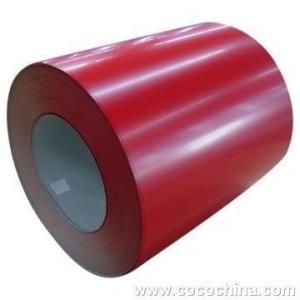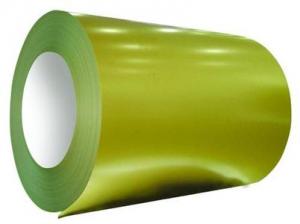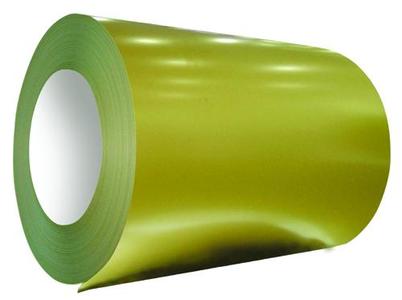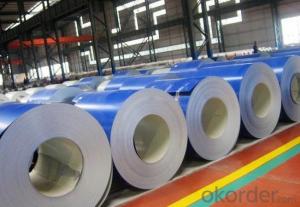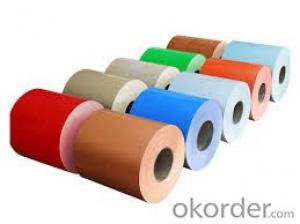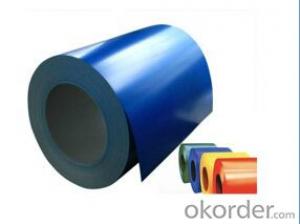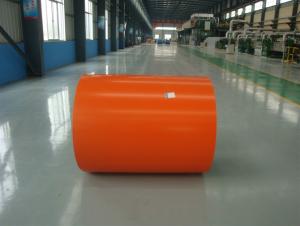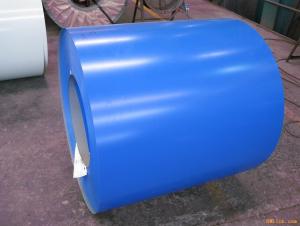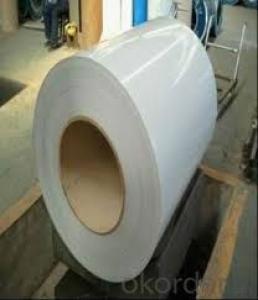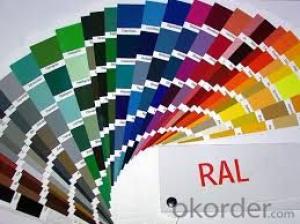PRE-PAINTED GALVANIZED STEEL COIL
- Loading Port:
- Tianjin
- Payment Terms:
- TT OR LC
- Min Order Qty:
- -
- Supply Capability:
- 12000 m.t./month
OKorder Service Pledge
Quality Product, Order Online Tracking, Timely Delivery
OKorder Financial Service
Credit Rating, Credit Services, Credit Purchasing
You Might Also Like
THICKNESS:0.18mm-1.5mm
WIDTH:900mm-1250mm
COATING MASS:Z30-Z275
PAINT:PE、HP、HDP、PVDF、SMP、MATT、PVDF
COLOR:RAL Scale
COIL INNER DIAMETER:508mm/610mm
COIL WEIGHT:3mt-7mt
BASE MATERIAL:Hot-dip GALVANIZED Steel
- Q: I'm doing a project on stainless steel dining utensils and its a little more difficult than i thought it would be. There are no sites on the web that tells the creator or when it was first used. There's no sites that that i can see of that talk about the history of stainless steel dining utensils, only dining utensils in general. Please help, i can't change my project now ):
- The development of 18/10 stainless steel was the brainchild of Harry Brearley who, in 1913, was working on a project to prevent rifle barrels from corroding so much during use. His analysis of the rifle barrels involved having to dissolve them in acid but, by chance, he noticed that steel which had a high chromium content did not dissolve in the acid. He experimented with varying proportions of chromium and finally produced a stainless steel with 12.8% chromium. He moved to Thos Firth Sons in 1914 and commercial production of stainless steel cutlery began. Refinements were necessary because early versions of stainless steel knives were harder to produce and polish, and they would not cut as well as the existing knives.
- Q: What are the different types of steel finishes available for coils?
- There are several types of steel finishes available for coils, including hot rolled, cold rolled, galvanized, and stainless steel. Hot rolled steel has a rough surface and is often used for structural applications. Cold rolled steel has a smoother surface and is commonly used in appliances and automotive parts. Galvanized steel has a protective zinc coating to prevent corrosion and is used in outdoor applications. Stainless steel is resistant to corrosion and staining, making it suitable for food processing and medical equipment.
- Q: Who started or popularized the use of the steel guitar in country music? Early country songs contained no steel guitars but by 1950 the steel guitar had become a staple of country music.
- The Lap steel guitar evolved from the Hawaiian guitar. Then came the console steel guitar with muliple necks to which were added pedals (by the Gibson Guitar Corporation), the instrument being named the Electraharp. An early player of this instrument was Alvino Rey. Pioneers of the Pedal Steel were Adolph Ricken backer, Paul Bigsby and Leo Fender. Paul Bigsby began making Pedal Steel Guitars in 1948, and Speedy West used the second of these to be built, and used extensively in his work with Jimmy Bryant. The likes of Shot Jackson, Buddy Emmons, Ralph Mooney, Zane Beck and Jimmy Day mechanically enhanced the steel guitar, and gave us the machines which are found today.
- Q: Iron melts faster when there will be low carbon in Iron.During steel making the molten Iron gets purified and alloying being done through the process. How the carbon is being controlled at Iron melting stage and what it is called?
- It's not really that hard. You can use your charcoal grill to do it. First build a large fire in it and then bury the steel in the coals. It'll only take about ten minuites or so for the steel to heat through. Then pick it out of the coals with tongs and drop it into a bucket of water. Repeat as desired. Eventually it'll get as brittle as glass. To fix this, you must anneal the metal. Again heat the metal in the coals, only this time let it stay there until the coals go all the way out all by themselves. Next day when all the way cool, Take it out and clean it off. Viola!, you have hardened steel.
- Q: I got a muzzy carp point arrow and its head is steel with 1.7% carbon, its used in the water. Will i have to dry it after every use or is it stainless. Thanks
- carbon will rust.. stainless doesn't rust unless it touches carbon so its definitely not stainless. Since its only 1.7% its extremely unlikely that it will rust unless you leave it outside for extreme long periods of time. Either way you should take care of it. Put it in the garage or something but you don't have to dry it after every use.
- Q: How are steel coils used in the manufacturing of automotive frames?
- Steel coils are used in the manufacturing of automotive frames by being shaped, cut, and welded into different sections to create the structural framework of the vehicle. These coils provide the necessary strength and durability required to support the weight of the vehicle and withstand various stresses, ensuring the safety and stability of the automotive frame.
- Q: What are the common coil weight and width combinations available for steel coils?
- The common coil weight and width combinations available for steel coils vary depending on the specific requirements of the industry or application. However, some commonly available coil weight and width combinations for steel coils include: 1. Light gauge coils: These coils typically have a weight range of 5 to 10 tons and a width range of 600 to 1,500 mm. They are commonly used in industries such as automotive, construction, and appliances. 2. Medium gauge coils: These coils generally have a weight range of 10 to 20 tons and a width range of 750 to 2,000 mm. They find applications in sectors like manufacturing, infrastructure, and engineering. 3. Heavy gauge coils: These coils typically have a weight range of 20 to 35 tons and a width range of 900 to 2,200 mm. They are commonly used in industries that require thicker and wider steel sheets, such as shipbuilding, oil and gas, and construction of large structures. 4. Narrow coils: These coils have a width range of less than 600 mm and can have varying weights depending on the specific requirements. They are often used in industries that require narrower strips of steel, such as automotive components, electrical appliances, and packaging. 5. Custom coil sizes: Apart from the above standard coil weight and width combinations, manufacturers can also provide custom sizes based on specific customer requirements. This allows for flexibility in meeting the unique needs of different industries. It is important to note that these weight and width combinations are not exhaustive and can vary depending on the steel manufacturer, production capabilities, and customer demands.
- Q: How are steel coils used in the manufacturing of suspension systems?
- Steel coils are used in the manufacturing of suspension systems as they provide the necessary support and cushioning for vehicles. These coils, also known as coil springs, are placed between the vehicle's chassis and the wheels to absorb impact and ensure a smooth ride. The steel coils are designed to compress and expand under the weight and movement of the vehicle, effectively absorbing shocks, vibrations, and uneven road surfaces. This helps to improve stability, handling, and overall comfort for the driver and passengers.
- Q: Explain your answers please. I was watching mythbusters and they bought a steel coffin over a wooden one because they thought it would hold more dirt. Now how come bridges that have been made of wood lasted way longer than steel bridges? Or rollercoasts for example.
- Back when I was in school we used to have a contest comparing balsa wood bridge designs. The idea was to build the strongest bridge when derated for bridge weight. The strength test was that the 2-ft long bridge was placed between two tables and a garbage can was strung up to the middle of it. Then it was slowly filled with water until the bridge snapped. The can was weighed and divided by the bridge weight to get our scores. I don't see why you couldn't do this to compare wood vs steel. You could find how much load is needed to snap sample rods. The important point is that the rods should be nearly identical in dimensions between the two materials-- this means length and diameter. Also if you're measuring steel, you'd want to choose a relatively thin diameter or a long span or you won't be able to even bend it. Also while I'm pretty sure wood will snap, steel might bend gradually, so you'd have to decide how much deformation you would allow before calling the piece failed. Also if you take this approach be sure to wear safety glasses when running it. In fact it would be a good idea to put a metal shroud around the test structure.
- Q: I have been wanting a new pair of hiking boots, but haven't had the money. I just got a job that requires me to have steel toed boots. The job is only for a few weeks, but I may be required to wear them on other jobs in the future. Regardless of which style I get, I will most likely be buying Red Wing boots. On their website, I see they have steel toed hiking boots. What is the purpose of a steel toed hiking boot? Why would a hiker need to have steel toed boots? Wouldn't that just be more weight? I see that some of their hiking boots have aluminum toes, claiming to be 33% lighter than steel with the same protection. Would these boots be good potential hiking boots as well as suitable for construction or should I just focus on work boots and buy myself some hiking boots at a later date?
- Steel Toe Hiking Boots
Send your message to us
PRE-PAINTED GALVANIZED STEEL COIL
- Loading Port:
- Tianjin
- Payment Terms:
- TT OR LC
- Min Order Qty:
- -
- Supply Capability:
- 12000 m.t./month
OKorder Service Pledge
Quality Product, Order Online Tracking, Timely Delivery
OKorder Financial Service
Credit Rating, Credit Services, Credit Purchasing
Similar products
Hot products
Hot Searches
Related keywords
